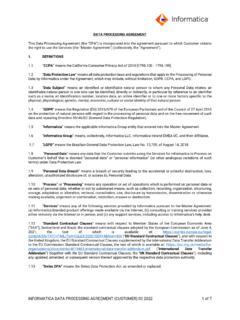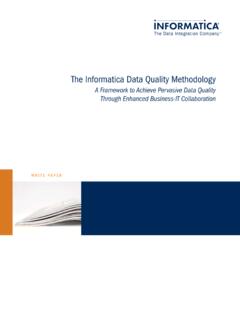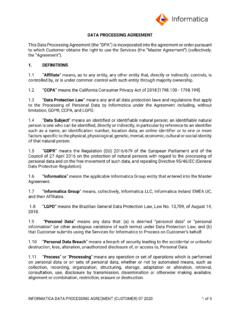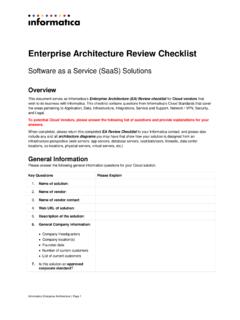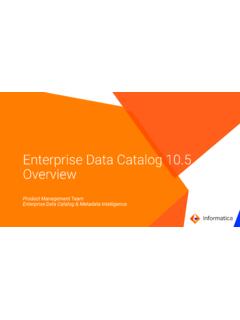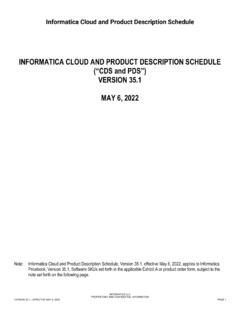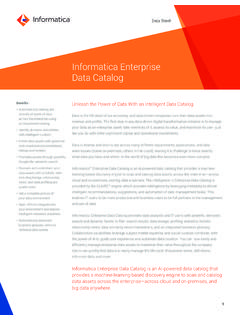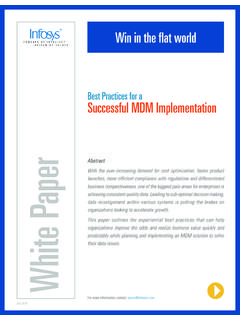Transcription of How to Manage Reference Data - Informatica
1 Your guide to planning and implementing a Reference data management strategy to improve IT efficiencyHow to Manage Reference DataWhite PaperAbout Informatica Digital transformation changes expectations: better service, faster delivery, with less cost. Businesses must transform to stay relevant and data holds the answers. As the world s leader in Enterprise Cloud data management , we re prepared to help you intelligently lead in any sector, category or niche. Informatica provides you with the foresight to become more agile, realize new growth opportunities or create new inventions. With 100% focus on everything data , we offer the versatility needed to succeed. We invite you to explore all that Informatica has to offer and unleash the power of data to drive your next intelligent of ContentsExecutive Summary.
2 4 What is Reference data ? .. 4 Challenges in Managing Reference data .. 5 Best Practices for Implementing a Reference data Project .. 6 Capabilities to Look for in a Reference data management Solution .. 8 How Reference data management Benefits Organizations .. 9 Reference data management in 9 Conclusion .. 103 Executive Summary IT teams are constantly looking for ways to improve efficiency. To that end, many are streamlining data management by using a master data management (MDM) strategy to provide a single, consistent view of business data across the enterprise. MDM removes disparate, duplicate, and conflicting information to simplify reporting and business intelligence and enable better business decisions.
3 Yet a key area of data management complexity overlooked by many is the management of Reference data . While the lookup tables that many organizations use to give users consistent values to choose when entering data such as dates, countries, gender, or industry into a database or application may appear to be simple, managing this information across a large enterprise is deceptively white paper gives you an overview of what Reference data is, the challenges organizations face in managing it, best practices and capabilities necessary in a solution, and how the right tool can remove operational overhead so that organizations can boost is Reference data ?If you were to broadly characterize all the key business data in your enterprise, you d find four types: 1.
4 Transactional data that comes from applications and operational datastores2. master data that provides a consistent definition of business entities across multiple IT systems in the enterprise3. Metadata that describes the structure of an entity4. Reference data Known by many different names lookup values, lists, code data tables, domain values, drop-down values, or enumeration values Reference data describes the code and value pairs built into code tables that provide a list of allowed values for a given field in an application or database. Most enterprise applications use Reference data to classify and categorize product, customer, and supplier information. Examples include state codes, country codes, gender codes, and marital status codes.
5 Many international and industry-specific standards define Reference data standards; for example, the North American Industry Classification System (NAICS) provides codes that classify business establishments. While the amount of Reference data in most organizations is relatively small, this type of data can be found everywhere in data warehouses, extract-transform-load (ETL) mappings, spreadsheets, relational databases, and more. 4 Challenges in Managing Reference DataAmong the biggest obstacles that organizations face in working with Reference data is that different applications may rely on different variations of code sets to define the same thing. For example, their CRM and ERP solutions might use different country code types.
6 As a result, integrating data across applications requires organizations to translate between the different code table representations to categorize data in a consistent manner. Today, many organizations reconcile this data as well as track any changes to it using ad hoc and error-prone manual methods. Others are unaware they need consistent Reference data because they re accustomed to tolerating inconsistencies. Errors in the Reference data can have major business impacts. Reports meant for internal or external audiences that pull data from multiple applications and departments can be inaccurate. When heavily regulated industries, such as financial services or healthcare, provide inaccurate reports to regulators they can be subject to heavy fines and reputational damage.
7 Poor quality data can also cause major issues in downstream applications. As they synchronize values and Manage changes across the enterprise, organizations face the following challenges:Managing Multiple Codes and Their MappingReference data coding systems can be quite complex. Take the case of country codes. Several systems represent countries and dependent areas, and some of these schemes offer multiple coding options. The best-known method, ISO 3166-1, offers three sets of codes, as illustrated here:Alpha-2 Alpha-3 NumericUSUSA840 Industry codes are another case in point. NAICS replaced the Standard Industrial Classification (SIC) codes in 1997. Yet some regulatory reports continue to demand SIC codes. In addition, the European community uses the Nomenclature Statistique des Activit s economiques dans la Communaut Europ enne (NACE) classification for the same purpose but employs different codes.
8 If you are a global organization doing business in different countries, you must map these codes correctly to be compliant in your IntegrationOne of the primary reasons for data integration project failures is poor Reference data mapping. Most organizations use different codes to represent Reference data in different enterprise applications because application owners choose the codes and descriptions that best suit them. An online bill payment service may be represented in the billing system as OBS, while the customer information file may call it BILLPAY. To integrate this data , organizations must map OBS in the billing system, and BILLPAY in the customer information file to one single service type in the MDM system in order to create a single view of customers and their contracts.
9 This challenge is compounded by the fact that data integration projects often deal with thousands of code value pairs. 5 Inconsistent Enterprise-Wide Representation Most organizations do not represent Reference data consistently at an enterprise level. As mentioned previously, Reference data is often application specific, which leads to siloed data management . Moreover, whether the codes are internal or external, they tend to change over time. When codes change, the inability to maintain Reference data centrally drives significant effort and cost for the enterprise. Mergers and acquisitions, rapid growth in data volume, complexity of Reference data , and lack of governance and absence of enterprise-wide single view further increase operational Practices for Implementing a Reference data SolutionOrganizations need a robust Reference data management strategy to avoid major data quality issues that affect reporting, regulatory compliance, transactions, and ultimately their ability to understand their data .
10 Best Practices for planning and implementing a Reference data strategy require three phases: Consolidation, management , and Distribution. Each phase consists of the following tasks. ConsolidationThe first step is to create a golden copy of Reference data by consolidating all of the organization s Reference data into a central repository. Organizations can use the repository to Manage Reference data across the enterprise to achieve standardization, quality, and operational efficiency. Tasks include: Discovery. Create a list of all Reference data sets necessary for smooth functioning of the business. Base this list on what is important for the enterprise as a whole rather than the demands of individual applications.
